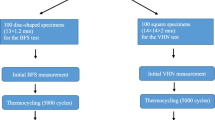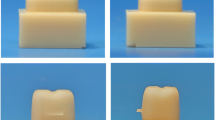Abstract
This study compares the mechanical properties of commercially available CAD/CAM (Computer-Aided Design/Computer-Aided Manufacturing) millable dental blocks including Vita Enamic, Lava Ultimate, and MAZIC Duro. All the discs were cut in dimension of 1.2 mm in thickness and 12 mm in diameter, ground up to #1200 Sic papers and polished. The biaxial flexure strength of the ceramic discs was measured after thermocycling treatment and the broken surfaces were observed using scanning electron microscopy (SEM). The discs were brushed using a toothbrush testing machine under a 150 g load. Surface roughness and morphology were determined after toothbrushing cycles. Finally, the friction and wear behavior of the materials against an opposing tooth were studied using a reciprocating pin-on-plate test configuration. The vertical loss of dental cusp was measured, and the surface image was examined using field emission scanning electron microscopy (FE-SEM). The biaxial flexural strength data were subjected to Weibull analysis. To compare the significance between the groups, all data were analyzed by one-way analysis (ANOVA). The biaxial flexural strength of the Lava Ultimate and MAZIC Duro materials is significantly higher than that of Vita Enamic. In addition, Lava Ultimate and MAZIC Duro exhibited significantly smoother surfaces than that of Vita Enamic after toothbrushing. Lava Ultimate and MAZIC Duro also showed less wear to the opposing tooth than that of Vita Enamic. In addition, Lava Ultimate possesses more suitable mechanical properties than the Vita Enamic and Mazic Duro for use in oral clinical prosthesis.






Similar content being viewed by others
References
Miyazaki T, Hotta Y, Kunii J, Kuriyama S, Tamaki Y. A review of dental CAD/CAM: current status and future perspectives from 20 years of experience. Dent Mater J. 2009;28:44–56.
Miyazaki T, Nakamura T, Matsumura H, Ban S, Kobayashi T. Current status of zirconia restoration. J Prosthodont Res. 2013;57:236–61.
Boitelle P, Mawussi B, Tapie L, Fromentin O. A systematic review of CAD/CAM fit restoration evaluations. J Oral Rehabil. 2014;41:853–74.
Fasbinder DJ. Computerized technology for restorative dentistry. Am J Dent. 2013;26:115–20.
Liu P-R, Essig ME. Panorama of dental CAD/CAM restorative systems. Compend Contin Educ Dent (Jamesburg, NJ 1995). 2008;29:482–84.
Hickel R, Manhart J. Longevity of restorations in posterior teeth and reasons for failure. J Adhes Dent. 2001;3:45–64. https://doi.org/10.1038/sj.bdj.2012.137.
Manhart J, Chen H, Hamm G, Hickel R. Buonocore memorial lecture. review of the clinical survival of direct and indirect restorations in posterior teeth of the permanent dentition. Oper Dent. 2004;29:481–508.
Giordano R. Materials for chairside CAD/CAM–produced restorations. J Am Dent Assoc Am Dental Assoc. 2006;137:14S–21S.
Lauvahutanon S, Takahashi H, Shiozawa M, Iwasaki N, Asakawa Y, Oki M, et al. Mechanical properties of composite resin blocks for CAD/CAM. Dent Mater J. 2014;33:705–10.
Martin MP. Material and clinical considerations for full-coverage indirect restorations. Compend Contin Educ Dent. 2012;33:2–5.
Koller M, Arnetzl GV, Holly L, Arnetzl G. Lava ultimate resin nano ceramic for CAD/CAM: customization case study. Int J Comput Dent. 2012;15:159–64.
Yamanel K, Çaglar A, GÜLSAHI K, Özden UA. Effects of different ceramic and composite materials on stress distribution in inlay and onlay cavities: 3-D finite element analysis. Dent Mater J. 2009;28:661–70.
Höland W, Schweiger M, Watzke R, Peschke A, Kappert H. Ceramics as biomaterials for dental restoration. Expert Rev Med Devices. 2008;5:729–45.
Özcan M, Barbosa SH, Melo RM, Galhano GÁP, Bottino MA. Effect of surface conditioning methods on the microtensile bond strength of resin composite to composite after aging conditions. Dent Mater. 2007;23:1276–82
Rinastiti M, Özcan M, Siswomihardjo W, Busscher HJ. Effects of surface conditioning on repair bond strengths of non-aged and aged microhybrid, nanohybrid, and nanofilled composite resins. Clin Oral Investig. 2011;15:625–33
Matinlinna JP. Handbook of oral biomaterials. CRC press, Boca Raton 2014.
Ritter JE. Predicting lifetimes of materials and material structures. Dent Mater Elsevier. 1995;11:142–6.
Kelly JR. Perspectives on strength. Dent Mater. 1995;11:103–10.
van der Zwaag S. The concept of filament strength and the Weibull modulus. J Test Eval ASTM Int. 1989;17:292–98.
Choi BJ, Kim SC, Im YW, Lee JW, Lee HH. Uniaxial and biaxial flexural strengths of resin-composite CAD-CAM blocks. Dent Mater. 2015;31:e31–2.
Bakke M, Holm B, Jensen BL, Michler L, Møller E. Unilateral, isometric bite force in 8-68-year-old women and men related to occlusal factors. Eur J Oral Sci Wiley Online Library. 1990;98:149–58.
Helkimo E, Carlsson GE, Helkimo M. Bite force and state of dentition. Acta Odontol Scand Taylor Francis. 1977;35:297–303.
Alonso V, Caserio M. A clinical study of direct composite full-coverage crowns: long-term results. Oper Dent. 2012;37:432–41.
Preissner S, Kostka E, Blunck U. A noninvasive treatment of amelogenesis imperfecta. Quintessence Int (Berl). 2013;44.
Güth J, Almeida E, Silva JS, Ramberger M, Beuer F, Edelhoff D. Treatment concept with CAD/CAM-fabricated high-density polymer temporary restorations. J Esthet Restor Dent. 2012;24:310–8.
Harrington E, Jones PA, Fisher SEWH. Toothbrush-dentifrice abrasion-a suggested standard method. Br Dent J. 1982;153:135–8.
DeLong R. Intra-oral restorative materials wear: rethinking the current approaches: how to measure wear. Dent Mater. 2006;22:702–11.
Hara AT, Livengood SV, Lippert F, Eckert GJ, Ungar PS. Dental surface texture characterization based on erosive tooth wear processes. J Dent Res. 2016;95:537–42.
Figueiredo-Pina CG, Patas N, Canhoto J, Cláudio R, Olhero SM, Serro AP, et al. Tribological behaviour of unveneered and veneered lithium disilicate dental material. J Mech Behav Biomed Mater. 2016;53:226–38.
Lambrechts P, Debels E, Van Landuyt K, Peumans M, Van Meerbeek B. How to simulate wear?: overview of existing methods. Dent Mater. 2006;22:693–701.
Kadokawa A, Suzuki S, Tanaka T. Wear evaluation of porcelain opposing gold, composite resin, and enamel. J Prosthet Dent. 2006;96:258–65.
Harrison A. Wear of combinations of acrylic resin and porcelain, on an abrasion testing machine. J Oral Rehabil. 1978;5:111–5.
Elmaria A, Goldstein G, Vijayaraghavan T, Legeros RZ, Hittelman EL. An evaluation of wear when enamel is opposed by various ceramic materials and gold. J Prosthet Dent. 2006;96:345–53.
Preis V, Behr M, Handel G, Schneider-Feyrer S, Hahnel S, Rosentritt M. Wear performance of dental ceramics after grinding and polishing treatments. J Mech Behav Biomed Mater. 2012;10:13–22.
Osiewicz MA, Werner A, Pytko-Polonczyk J, Roeters FJM, Kleverlaan CJ. Contact-and contact-free wear between various resin composites. Dent Mater. 2015;31:134–40.
Hahnel S, Schultz S, Trempler C, Ach B, Handel G, Rosentritt M. Two-body wear of dental restorative materials. J Mech Behav Biomed Mater. 2011;4:237–44.
Condon JRFJL. Evaluation of composite wear with a new multi-mode oral wear simulator. Dent Mater. 1996;12(4):218–26.
Mair LH, Stolarski TA, Vowles RW, Lloyd CH. Wear: mechanisms, manifestations and measurement. Report of a workshop. J Dent. 1996;24:141–8.
Acknowledgements
This research did not receive any specific Grant from funding agencies in the public, commercial, or not-for-profit sectors.
Author information
Authors and Affiliations
Corresponding author
Ethics declarations
Conflict of interest
The authors declare that they have no conflicts of interest.
Additional information
Publisher’s Note
Springer Nature remains neutral with regard to jurisdictional claims in published maps and institutional affiliations.
Rights and permissions
About this article
Cite this article
Yin, R., Kim, YK., Jang, YS. et al. Comparative evaluation of the mechanical properties of CAD/CAM dental blocks. Odontology 107, 360–367 (2019). https://doi.org/10.1007/s10266-018-0407-9
Received:
Accepted:
Published:
Issue Date:
DOI: https://doi.org/10.1007/s10266-018-0407-9




